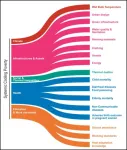Under strict embargo: 16:00hrs BST 25 September 2023
Peer reviewed
Observational study
People
Antiviral drug linked to SARS-CoV-2 mutations
Researchers at the Francis Crick Institute, the University of Cambridge, Imperial College London, the University of Liverpool, the University of Cape Town and UKHSA have uncovered a link between an antiviral drug for COVID-19 infections called molnupiravir and a pattern of mutations in the SARS-CoV-2 virus.
Molnupiravir works by inducing mutations in the virus’s genetic information, or genome, during replication. Many of these mutations will damage or kill the virus, reducing viral load in the body. It was one of the first antivirals available on the market during the COVID-19 pandemic and was widely adopted by many countries.
In research published in Nature today, the scientists used global sequencing databases to map mutations in the SARS-CoV-2 virus over time. They analysed a family tree of 15 million SARS-CoV-2 sequences so that at each point in each virus’s evolutionary history they could see which mutations had occurred.
Although viruses mutate all the time, the researchers identified mutational events in the global sequencing database which looked very different to typical patterns of COVID-19 mutations, and that they were strongly associated with individuals who had taken molnupiravir.
These mutations increased in 2022, coinciding with the introduction of molnupiravir. They were also more likely to be seen in older age groups, consistent with the use of the antivirals to treat people who are more at risk, and in countries which are known to have high molnupiravir use. In England, the researchers analysed treatment data and found that at least 30% of the events involved use of molnupiravir.
The causes of mutational events can be traced by looking at their ‘mutational signature’: a preference for mutations to occur at particular sequences in the genome. The researchers found a close match between the signature seen in these mutational events and the signature in clinical trials of molnupiravir.
The researchers also saw small clusters of mutations which suggests onward transmission from one person to another, although no established variants of concern are currently linked to this signature.
Understanding the impact of molnupiravir treatment on the risks of new variants, and any impact they might have on public health is difficult. It is also important to consider that chronic COVID-19 infections, which molnupiravir is used for, can themselves result in new mutations.
Theo Sanderson, lead author and postdoctoral researcher at the Francis Crick Institute, said: “COVID-19 is still having a major effect on human health, and some people have difficulty clearing the virus, so it’s important we develop drugs which aim to cut short the length of infection. But our evidence shows that a specific antiviral drug, molnupiravir, also results in new mutations, increasing the genetic diversity in the surviving viral population.
“Our findings are useful for ongoing assessment of the risks and benefits of molnupiravir treatment. The possibility of persistent antiviral-induced mutations needs to be taken into account for the development of new drugs which work in a similar way. Our work shows that the unprecedented size of post-pandemic sequence datasets, collaboratively built by thousands of researchers and healthcare workers around the world, creates huge power to reveal insights into virus evolution that would not be possible from analysis of data from any individual country.'”
Christopher Ruis from the Department of Medicine at the University of Cambridge, said: “Molnupiravir is one of a number of drugs being used to fight COVID-19. It belongs to a class of drugs that can cause the virus to mutate so much that it is fatally weakened. But what we’ve found is that in some patients, this process doesn’t kill all the viruses, and some mutated viruses can spread. This is important to take into account when assessing the overall benefits and risks of molnupiravir and similar drugs.”
-ENDS-
For further information, contact: press@crick.ac.uk or +44 (0)20 3796 5252
Notes to Editors
Reference: Sanderson, T. et al. (2023). A molnupiravir-associated mutational signature in global SARS-CoV-2 genomes. Nature. 10.1038/s41586-023-06649-6.
The Francis Crick Institute is a biomedical discovery institute dedicated to understanding the fundamental biology underlying health and disease. Its work is helping to understand why disease develops and to translate discoveries into new ways to prevent, diagnose and treat illnesses such as cancer, heart disease, stroke, infections, and neurodegenerative diseases.
An independent organisation, its founding partners are the Medical Research Council (MRC), Cancer Research UK, Wellcome, UCL (University College London), Imperial College London and King’s College London.
The Crick was formed in 2015, and in 2016 it moved into a brand new state-of-the-art building in central London which brings together 1500 scientists and support staff working collaboratively across disciplines, making it the biggest biomedical research facility under a single roof in Europe.
http://crick.ac.uk/
About the University of Cambridge
The University of Cambridge is one of the world’s leading universities, with a rich history of radical thinking dating back to 1209. Its mission is to contribute to society through the pursuit of education, learning and research at the highest international levels of excellence.
Cambridge was second in the influential 2023 QS World University Rankings, the highest rated institution in the UK.
The University comprises 31 autonomous Colleges and over 100 departments, faculties and institutions. Its 20,000 students include around 9,000 international students from 147 countries. In 2022, 72.5% of its new undergraduate students were from state schools and more than 25% from economically disadvantaged backgrounds.
Cambridge research spans almost every discipline, from science, technology, engineering and medicine through to the arts, humanities and social sciences, with multi-disciplinary teams working to address major global challenges. In the Times Higher Education’s rankings based on the UK Research Excellence Framework, the University was rated as the highest scoring institution covering all the major disciplines.
A 2023 report found that the University contributes nearly £30 billion to the UK economy annually and supports more than 86,000 jobs across the UK, including 52,000 in the East of England. For every £1 the University spends, it creates £11.70 of economic impact, and for every £1 million of publicly-funded research income it receives, it generates £12.65 million in economic impact across the UK.
The University sits at the heart of the ‘Cambridge cluster’, in which more than 5,200 knowledge-intensive firms employ more than 71,000 people and generate £19 billion in turnover. Cambridge has the highest number of patent applications per 100,000 residents in the UK.
www.cam.ac.uk
About the University of Liverpool
Founded in 1881 as the original ‘red brick’, the University of Liverpool is one of the UK’s leading research-intensive higher education institutions with an annual turnover of £597.6 million, including an annual research income of £146 million.
Consistently ranked in the top 200 universities worldwide, we are a member of the prestigious Russell Group of the UK’s leading research universities and have a global reach and influence that reflects our academic heritage as one of the country’s largest civic institutions. Visit www.liv.ac.uk or follow us on twitter at: http://www.twitter.com/livuninews
END









